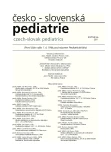Gastroesophageral reflux in pre-term infants: 24hour multichannel intraluminal impedance/pH metry
Authors:
R. Vyhnánek 1; E. J. Olafsdottir 2; P. Koťátko 1; D. Marková 1; M. Hladíková 1; P. Szitányi 1; P. Frühauf 1
Authors‘ workplace:
Klinika dětského a dorostového lékařství 1. LF UK a VFN, Praha
přednosta prof. MUDr. J. Zeman, DrSc.
1; Department of Pediatrics, Haukeland Universtiy Hospital, Bergen, Norsko
Head prof. B. Skadberg M. D., Ph. D.
2
Published in:
Čes-slov Pediat 2011; 66 (3): 141-145.
Category:
Original Papers
Overview
Aims:
The aim of our study was to evaluate 24-hour multichannel intraluminal impedance pH monitoring measurements in originally preterm infants, and also to compare different parameters that either depend or are independent from pH of the refluxate.
Methods:
Twenty six infants, rectruited from The Follow-up clinic of The Department of Pediatric and Adolescent Medicine of the First Medical Faculty of The Charles University and General University Hospital in Prague, have been evaluated at corrected age of 3 to 45 weeks, median 13 weeks, median of gestational age 29 weeks.
We used the Bolus Exposure Index to evaluate the significance of impedance measurement, with cut-off value of 1.4, as other authors in the past, even though the value has not been generally recognized in this group of children. For pH monitoring we used the generally recognized Boix-Ochoa Index of 16.6 as our cut-off value.
Results:
The examination showed prevalence of gastroesophageal reflux of 69.9% using impedance and 57.5% using pH in this group of infants. That corresponds to prevalence in otherwise healthy term infants as stated in the literature. Number of reflux episodes and Bolus Exposure Index, and also Bolus Exposure Index and Boix-Ochoa index correlate significantly.
Conclusion:
Prevalence of GER in our group of infants corresponds to that in otherwise healthy term infants. Statistically significant difference between impedance and pH in diagnosing GER has not been shown, correlation to symptoms is necessary however to evaluate the benefit of the methods used.
Key words:
impedance, pH metry, preterm infant, gastroesophageal reflux
Sources
1. Lapillonne A, Campeotto F, Dupont C. Trophic feeding and maturation of the gastrointestinal tract of the preterm infant. J Gynecol Obstet Biol Reprod (Paris). 2004; 33(1 Suppl): 127–128.
2. Al Tawil Y, Berseth CL. Gestational and postnatal maturation of duodenal motor responses to intragastric feeding. J Pediatr 1996; 129(3): 374–381.
3. Amaizu N, Shulman R, Schanler R, et al. Maturation of oral feeding skills in preterm infants. Acta Paediatr 2008; 97(1): 61–67.
4. Loots CM, Benninga MA, Davidson GP, et al. Addition of pH-impedance monitoring to standard pH monitoring increases the yield of symptom association analysis in infants and children with gastroesophageal reflux. J Pediatr 2009; 154(2): 248–252.
5. Richard JM, Hibbs AM. Diagnosing gastroesophageal reflux in preterm infants. Pediatrics 2006; 118(2): 793–794.
6. Orenstein SR. An overview of reflux-associated disorders in infants: apnea, laryngospasm, and aspiration. Am J Med 2001; Suppl 8A 111(3): 60–63.
7. Kleinman L, Rothman M, Strauss R, et al. The infant gastroesophageal reflux questionnaire revised: development and validation as an evaluative instrument. Clin Gastroenterol Hepatol 2006; 4(5): 588–596.
8. Tolia V, Vandenplas Y. Systematic review: the extra-oesophageal symptoms of gastro-oesophageal reflux disease in children. Aliment Pharmacol Ther 2009; 29(3): 258–272.
9. Sherman PM, Hassall E, Fagundes-Neto U, et al. A global, evidence-based consensus on the definition of gastroesophageal reflux disease in the pediatric population. Am J Gastroenterol 2009; 104(5): 1278–1295.
10. Frühauf P, Vyhnanek R. Kojenecké ublinkávání (GER) a jeho léčba. Pediatrie pro praxi 2008; 9(6): 408–410.
11. Vandenplas Y. Gastroesophageal reflux. In: Wyllie R, Hyams JS. Pediatric Gastrointestinal and Liver Disease. 3rd ed. Saunders Elsevier, 2006: 305–325.
12. Shay S. Esophageal impedance monitoring: The ups and downs of a new test. Am J Gastroenterol 2004; 99: 1020–1022.
13. Lee SH, Jang JY, Yoon IJ, et al. Usefulness of multichannel intraluminal impedance-pH metry in children with suspected gastroesophageal reflux disease. Korean J Gastroenterol 2008; 52(1): 9–15.
14. Condino AA, Sondheimer J, Pan Z, et al. Evaluation of infantile acid and nonacid gastroesophageal reflux using combined pH monitoring and impedance measurement. J Pediatr Gastroenterol Nutr 2006; 42(1): 16–21.
15. López AM, Moya MJ, Cabo JA, et al. Acid and non-acid gastro-esophageal reflux in newborns. Preliminar results using intraluminal impedance. Cir Pediatr 2005; 18(3): 121–126.
16. Wenzl TG. Evaluation of gastroesophageal reflux events in children using multichannel intraluminal electrical impedance. Am J Med 2003;115(Suppl 3A): 161–165.
17. Wenzl TG, Schenke S, Peschgens T, et al. Association of apnea and nonacid gastroesophageal reflux in infants: Investigations with the intraluminal impedance technique. Pediatr Pulmonol 2001; 31(2): 144–149.
18. López AM, Moya MJ, Cabo JA, et al. Twenty-four-hour esophageal impedance-pH monitoring in healthy preterm neonates: rate and characteristics of acid, weakly acidic, and weakly alkaline gastroesophageal reflux. Pediatrics 2006; 118(2): 299–308.
19. Nelson SP, et al. Prevalence of symptoms of gastroesophageal reflux during infancy. A pediatric practice-based survey. Pediatric Practice Research Group. Arch Pediatr Adolesc Med 1997; 151: 569–572.
20. Salvatore S, Hauser B, Devreker T, et al. Esophageal impedance and esophagitis in children: any correlation? J Pediatr Gastroenterol Nutr 2009; 49(5): 566–570.
21. Vandenplas Y, Rudolph CD, Di Lorenzo C, et al. Pediatric gastroesophageal reflux clinical practice guidelines: Joint recommendations of the North American Society for Pediatric Gastroenterology, Hepatology, and Nutrition (NASPGHAN) and the European Society for Pediatric Gastroenterology, Hepatology, and Nutrition (ESPGHAN). J Pediatr Gastroenterol Nutr 2009; 49(4): 498–547.
Labels
Neonatology Paediatrics General practitioner for children and adolescentsArticle was published in
Czech-Slovak Pediatrics

2011 Issue 3
- What Effect Can Be Expected from Limosilactobacillus reuteri in Mucositis and Peri-Implantitis?
- The Importance of Limosilactobacillus reuteri in Administration to Diabetics with Gingivitis
Most read in this issue
- Pulse oximetry as a screening method for early detection of critical congenital heart disease in newborns in the region of Northern Slovakia
- Disorders in food intake from the child psychiatrist point of view
- Pulse oximetry and critical congenital heart defects in newborns – the discussion continues
- Gastroesophageral reflux in pre-term infants: 24hour multichannel intraluminal impedance/pH metry
